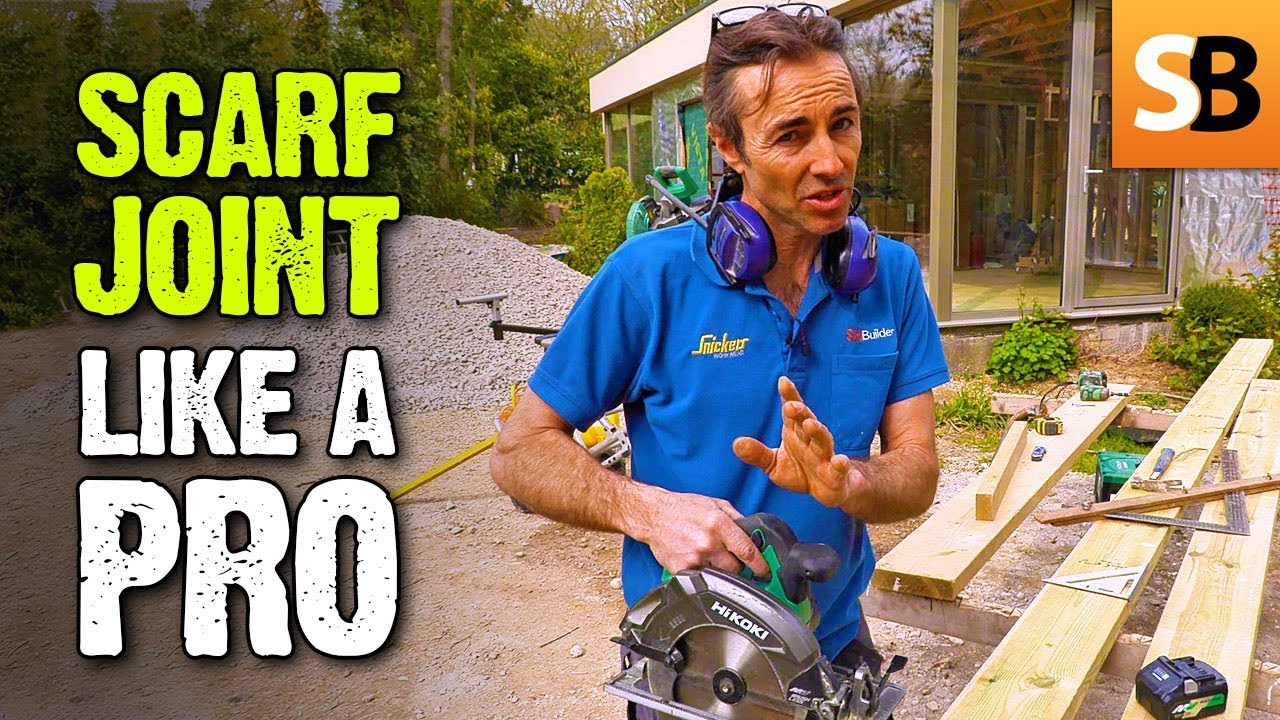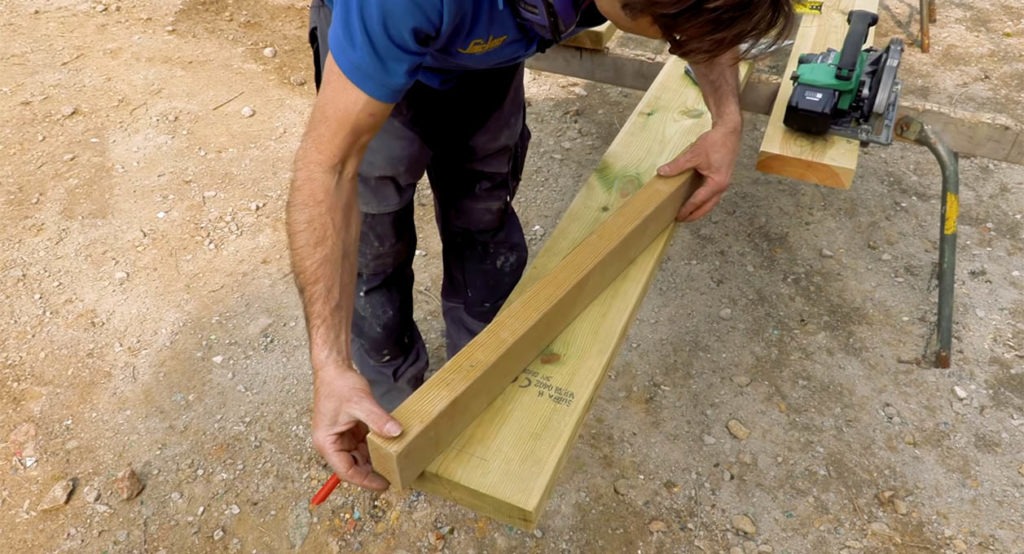HiKOKI Cordless Saw
Robin loves a scarf joint and in this video, he shows you how to create a scarf joint using his new Hikoki 36v cordless circular saw.
If you’ve got two lengths of timber that need to be joined together, it’s time to create a scarf joint. Calculate the height of the timber times three which is the length for the joint.
What we do is create a set of folding wedges. When we drive the folding wedges together it pushes one timber one way, it pushes the other in the opposite direction, and then we finish it with a mechanical fixing in the centre. The joint will hold without a mechanical fixing, but we like a belt and braces approach.
In fact, I often use them without mechanical fixing. There’s no glue involved. Quite often if it’s a hip rafter, for example, which is where I use them all the time, or a ridge.
Because of the length of the joint, you might have a jack rafter fixing right over it, sometimes in a couple of places, and that actually clamps it. It’s a beautiful job.
The other thing to say about the riving knife, if you’re cutting a lot of sheet material, make sure your sheet material is well supported, because as you’re going through, if it gives you a little bind, whereas the riving knife would hold that bind, this isn’t going to do that.
It’s likely to kick back, so you got to avoid that. Make sure your work’s well supported. The battery, again, 36 volts, this one’s fully charged, just come off charge. Take’s about 25 minutes, it’s really good and the high output batteries perform well.
It’s got your indicator on the back, which shows you how much life it’s got. This will run until it’s finished. There’s no dullness. It will run, run, run, and just go boom, finished.
Marking Up
Let’s mark up the simple scarf joint. We just need a couple of bits here. This is the length of timber I’m going to put the scarf joint on. We only have to mark it out once. Even though it’s two pairs, it’s two parts to it, we only have to mark it out once. Let’s just that bit of shake off there.
The joint principle is three times … the length of the joint is three times the height of the timber that you’re joining. I’m going to round this up, just simply, to make it a little bit easier. I’m going to hold it 180, so it’s 300 plus 240. It’s 540. That’s the length of the joint. That’s three times the height. I’ve just got another shoulder line there, over to the other side.
I’ve got a section of timber (above), which is exactly the same thickness that way. I take the outside to the outside, and I’m going to mark on the opposite side, here. Then what I’m going to use is my speed square to run a couple of shoulders in.
Getting the angles right
It’s a 90-degree shoulder and the same on the other end, coming back there 90 degrees, there. And then all we need to do is put one in the middle, the same principle.
We’re going to cut that out now. Just going to check this is square out of in and out of the box. Pretty nice. This is where the magic begins. This usually happens on a customer’s drive, or anywhere I can find the space.
As you know, timber isn’t an exact science. A natural product, it moves, it bends, it bows, and we got to go with that sometimes.
You’ve got a stack of timber, you pick out the straightest ones for the most important components, a little bit like this. What I need to do is add this whole length onto the end of there, so I need a bit of space for that. Find a nice flat spot on the drive.
I’m going to run it over here, there. We get our piece we’re joining on, make sure the best end of it is going to be joined with that joint. If there’s any cup in the timber, that’s when the timbers go like that. Try to marry the cups up, don’t have the opposites.
Wood grains
Sometimes, just by looking at the end grain, you can see that if you match the end grain the chances are the cup’s going to be in the right place. But this particular structural timber is perfect and I haven’t really had a problem with it.
I’m going to lay that on the ground, and we’re going to lay that over the top, here, brush it off. But the most important thing now is to figure out which is the top of your timber. So, if this is the top of my timber I’m going to give it a little bit of bow. So when the joint goes in, and it goes into compression, it goes straight. It can only go straight.
It doesn’t sink. I’m going to look down that now, make sure it’s nice and true and straight. You can do a string line as well, but I know, from experience, where it needs to be, to be straight, and that’s it.
Now, it’s a matter of marking the male to the female with a pencil, and you can’t get better than that. If you try to mark the joint out to two separate bits and put them together, chances are you’ll have a few gaps, or it won’t exactly fit.
Now, there’s one more bit we need to cut, which is here, and the same there. You see, I’m just roughing it in. That’s 18 millimetres, roughly. That’s for a pair of folding wedges. I’ll put that back up on here. And we just make sure we’re going to cut off the bit we want to cut off, to repeat the process.
I’m going to mark my extra shoulder and cut that as I do it. The joint’s nearly ready, just got to adjust this one. The last bit to make is a pair of folding wedges, and we can just take that off of another cut.
Create a Scarf Joint with strength
Okay, now. We’ll demonstrate how strong this joint is. There are our folding wedges, will go in there. What I like to do is attach one, so when I push the other one, it doesn’t move. All right. We’re just going to tack that in there now.
It’s heartbreaking to see that. When I started putting this joint together, I used that to mark it, which is the same thickness. The only reason I do that is so when I make my folding wedges, it’s the right thickness. And it’s just years, and years, of trying them, practice.
You just think of the quickest way. It’s just an offcut. It’s all it is. Now, we need to demonstrate the strength of this, so we need a couple of bits of timber supported, and we’ll walk across it once it’s wedged together.
Get more wedge, pull that one over. The principle of this joint, I’m just going to mark an arrow on it in two places. That’s what’s happening as we bang the wedges in, a gentle tap. You can see, it’s pulling up now to the shoulder.
A good outcome
What do you think about a joint like that, straight off a circular saw? I mean, it’s what you want. This joint isn’t designed … It’s not for a floor joist, so don’t span big areas and do it for floor joists. It’s ideal for a hip rafter, side rail for a ridge, so the ridge will stop it from pulling apart.
Hip rafter’s got lots of support by jack rafters, but I’m just going to demonstrate. I’m only 65 odd kilos. I’m going to have a little walk across this, just-
I’m just strolled across it, to show that the strength is there and it won’t buckle under pressure.
I made the scarf joint with the HiKOKI brushless 36-volt cordless saw and it performed well and coped with it. The timber was fantastic structural timber that’s been dried out for ages inside, and it cut with no problem.
Now, if you want to see some more tips and tricks, just keep checking back to the channel. Please subscribe to our channel and check back for more carpentry tutorials.
Further Reading
More carpentry tutorials with Robin Clevett.
See more HiKOKI products on Skill Builder.
Find out more about the HiKOKI 36v Circular Saw.





